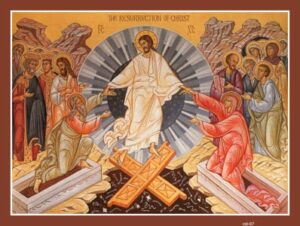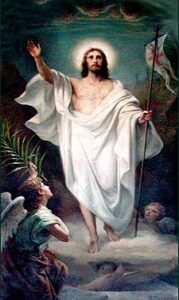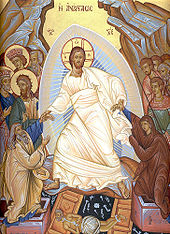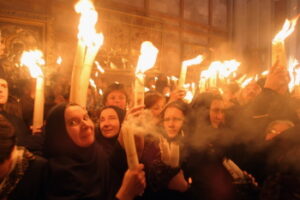The Orthodox resurrection icon depicts what is known as the harrowing of hell. It shows our God and Savior in hell setting the captives free. Where the Western image shows Christ by himself with the angel looking on, the Orthodox icon shows Christ surrounded by people. The Western depiction has a serenity like the calm after a storm, the Orthodox icon has more of a busy excitement of a military victory to it.
The teaching of the harrowing or the ransacking of hell is not confined to East. It is a catholic (universal) belief of the early Church. Western Christians confess it every time they recite the Apostles Creed:
He suffered under Pontius Pilate,
Crucified, died, and was buried,
He descended to the dead,
On the third day he rose again.
Because the Apostles’ Creed is part of both the Roman Catholic and the Protestant traditions, Reformed Christians should also have no problem affirming Christ’s descent into hell. Calvin in his Institutes (2.16.8) referred to it as “a matter of no small moment in bringing about redemption.”
How to Read an Icon
We do not so much look at an icon as we read an icon, that is, we discern the meanings behind the symbolism. Icons have been referred to as sermons in color. The best way to read an icon is to start at the center, at the person depicted, then to look outward.
The first thing we see is Christ all dressed in white which symbolizes the divine light or the heavenly realm. We also see the mandorla or orb of glory around him. These indicate Christ’s divinity and brings to mind the line in the Nicene Creed: “Light from Light, true God from true God.”
Next looking down we see Christ standing on top of the broken gates of hell. The doors are laid on top each other in the shape of the cross. Over the shattered doors we see in some icons Death defeated and in other icons we see a black abyss filled with the instruments of torture.
When reading an icon, we look at the subject’s hands. Looking to the right and left of the resurrection icon we see Christ grabbing hold of our ancestral parents Adam and Eve pulling them out of the tombs. If one looks closely we that it is Christ grabbing hold of them; we do not see them grabbing hold of Christ. This shows our salvation being dependent on Christ’s power, not on our strength. In the background we see a crowd of people, some having halos around their heads and others without a halo. The halos signify their being saints, that is, the perfection of their salvation. A hymn in the Great Friday Vespers has this stanza:
When You, the Redeemer of all, were placed in a new Tomb for us all, Hades, the respecter of none, crouched when he saw You. The bars were broken, the gates were shattered, the graves were opened, and the dead arose. Then Adam, gratefully rejoicing, cried out to You: “Glory to Your condescension, O Merciful God.”
East and West: Different Emphases
Christ’s death, burial, and resurrection are affirmed in both Western Christianity (Roman Catholic and Protestant) and in Eastern Orthodoxy. The differences in emphases reflect their respective theological paradigms. In the Western tradition greater emphasis is placed on the penal substitution understanding of salvation, that is, the innocent Son of God suffering or being punished on behalf of the law breakers who deserve eternal condemnation. In the Eastern tradition there seems to be a reticence to expound on the forensic understanding of Christ’s death on the Cross. It sees other themes like renewal and deification:
You transform the mortal by death, and the corrupt by burial; for as befits God, You have made incorruptible and immortal the nature you assumed; for Your body, O Master, did not see corruption, nor was Your soul abandoned as a stranger in Hades. (Great Friday Evening Service, Fifth Ode)
The Orthodox Church also interprets Christ’s death on the Cross typologically:
You came from a Virgin who knew no travail; Your side, O my Creator, was pierced by which You accomplished the re-creation of Eve, having Yourself become Adam. Supernaturally, You fell into a sleep that renewed nature, awakening life from sleep and corruption, as the Almighty. (Great Friday Evening Service, Fifth Ode)
As a Protestant I knew about typological interpretation but in these services I gain new insights into Christ’s death on the Cross. I had never thought of Eve’s coming from Adam’s rib (Genesis 2:21-22) as a type of the death and resurrection of Christ and the birth of the church!
In Orthodoxy there is an eagerness to expound on the significance of Christ’s resurrection. It views Christ’s resurrection as the reversal of the Fall, the creation of a new humanity, a great victory over Satan, our being released from death, the ultimate healing of our souls and bodies.
When You, the Immortal Life descended to Death, it was then, that You put Hades to death by the lightning of the Godhead; and when You raised up the dead from the infernal depths, all the Heavenly Powers cried aloud: “O Giver of Life, Christ our God, glory to You.” (Matins of the Resurrection)
There is the palpable sense in the Orthodox Pascha (Easter) Liturgy that one age has come to a close and a new age has begun. Over and over again we sing loudly and boldly:
“Christ is risen from the dead!
“Trampling down death by death!
“And upon those in the tomb bestowing life.




Dear Robert Arakaki: Have you read the following 5 books. These 5 books changed my thinking as much as my thinking is changeable (and I hope and pray my thinking is changeable in a more fully sanctified (by God) directed), toward agreement with the doctrines of Eastern Orthodoxy. I used to be formed on Lutheran and Pentecostal teachings, but I can no longer accept everything Luther and the Pentecostals taught (me).
Please see:
Gillquist, Fr. Peter. E. (1992). Becoming Orthodox: A Journey to the Ancient Christian Faith. Revised and Expanded Edition. Ben Lomond, CA: Conciliar Press.
Schaeffer, Frank. (2002). Dancing Alone: The Quest for Orthodox Faith in the Age of False Religions. Salisbury, MA: Regina Orthodox Press.
Azkoul, Fr. Michael. (2000). Once Delivered To the Saints: An Orthodox Apology For the New Millennium. Seattle, WA: St. Nectarios Press.
Saint Photios. (1987). The Mystagogy of the Holy Spirit. Joseph P. Farrell, Ph.D., trans. Brookline, MA: Holy Cross Orthodox Press.
Saint Photios. (1983). On the Mystagogy of the Holy Spirit. Holy Transfiguration Monastery, trans. Boston, MA: Studion Publishers.
God save us. Amen. In Erie PA Scott R. Harrington
Christ is Risen! May our risen Lord give you health, peace and the power to continue your work of confessing the orthodox faith in Him to the world!
Truly He is Risen!
May his love and mercy transform our lives and touch those around us.
Christ is risen!
Thanks for the lovely exposition of the Resurrection Icon, Robert. Holy Week in the Eastern Orthodox Christian tradition definitely represents the highlight of the year. I would say Holy Saturday is one of my favorite services, but Holy Week is such a seamless garment all the way through Holy Pascha, I can’t really prefer one service over the others. Obviously, the Paschal services are the highlight of the Orthodox year with good reason.
There is one interesting popular Reformed Protestant perspective here on Christ’s descent into hell (which I think illustrates well one consequence of the Western divergences in thought from the Eastern Church on this subject):
http://www.desiringgod.org/blog/posts/did-jesus-spend-saturday-in-hell–2
Thanks Karen for the article.
Is this not a classic example of how we Protestants (instinctively wanting connection to the Patristic/Historic Church) with a commentary and a little greek will carve up the creed to our liking — omitting what thousands of Bishops have embraced for 2 millennium — yet embracing the Roman Catholic Filioque addition/innovation to the creed after a thousand years with little careful thought. Go figure. The hubris is embarassing.
David, it’s a hubris I have often shared (and, truth be told, because I was and am considerably more ignorant than Pastor Piper, probably top many times). Alas, we are all sinners.
Hope you had a joyous Easter!
True…much hubris… but beware of the little demon of Orthodox Pride. We should have compassion and love towards one another since our disunity is due to the same Bishop’s prideful greed, who for the sake of keeping power over their own “jurisdictions,” keep Christians disunited in disobedience to the command of Christ our God.
John of Damascus on Holy Images Refuted Part 1
http://eternalpropositions.wordpress.com/2012/04/17/john-of-damascus-on-holy-images-refuted-part-1/
Hardly a refutation and a very week argument…I think I’ll stick with Saint John of Damascus and Orthodoxy! Rather than spending copious amounts of time trying to reinvent the church come home to the fullness of the faith in the Orthodox Church! In her is life and rest for one’s weary soul. Our work as Christians is not endless theological speculation. As his Eminence Archbishop Joseph stated at the end of this past Sundays Divine Liturgy, the purpose of the Christian life and the Church is “the salvation of our very souls”. Until you come to the Church you will not understand the veneration of the Saints. You will not love the saints and pay them their proper respect. Regarding Saint John of Damascus you attempt to critique what you don’t understand and fail to mention that he suffered for the sake of Christ when his hand was severed in retaliation for his writings. This is a man of profound faith and you would do well to ask him to pray for you!
Simply put, we should love who and what God loves and as Orthodox Christians we are quite certain that God loves the saints just as we are quite certain that Christ loves his Blessed Mother. We pay respect to those we love, to those who are in our family, and we ask them to pray for us just as we would ask someone in our biological family to pray for us.
Christ is Risen!
Bp. Hilarion Alfeyev of the Russian Orthodox Church has a wonderful book on Christ’s Descent into Hell. I recommend it to all who want to know the theological history and implications of this teaching from an Orthodox perspective.
http://www.amazon.com/Christ-Conqueror-Hell-Orthodox-Perspective/dp/0881410616/ref=sr_1_2?s=books&ie=UTF8&qid=1334630902&sr=1-2
Karen,
I just read that book during Lent. I’ve only been to six Pascha services (and only 4 as an Orthodox Christian), but that book made certain words and phrases and nuances jump out at me through Holy Week. I may try to revisit it next Lent, too!
Christ is risen!
Jamey
“I don’t think this is what the New Testament preaches.”
“I take these words to mean…”
“I think this is suggested as the more natural understanding of the passage…”
“I take “preached to the dead” to refer to those who, after being preached to, have since died.”
“I would say, therefore, that there is no textual basis in the New Testament for claiming that between Good Friday and Easter Christ was preaching to souls imprisoned in hell or Hades.”
“For these and other reasons, it seems best to me to omit from the Apostles Creed the clause, “he descended into hell,” rather than giving it other meanings that are more defensible…”
All quotes above from John Piper reveal a disconnect from the life of the Holy Spirit at work within the Church for the last 2,000 years, i.e. that dirty word Tradition.
Over and over again, he refers to himself…”I think…I would say…it seems best to me…” rather than the witness of the full counsel of God, those whom our Lord has used within His body the Church for the past two millennium. What gives him, or anyone for that matter, the authority to change a creed that has been professed for centuries? I suggest that the bedrock of Protestantism – Reformational Protestantism in particular – is the real problem. Semper Reformanda, or more specifically, Ecclesia Semper Reformanda est, meaning “The church is always being reformed,” has contributed to the fragmented state in current Protestantism of all types. The breaking away from Tradition has caused the Protestants to continually re-evaluate the Christian faith “in light of the Scriptures,” as they are wont to say.
What Piper teaches as doctrine is unambiguously blasphemous – as David Bentley Hart noted, it is a system likely worse than any of the ancient heresies. What he thinks about the Blessed Sabbath is best simply ignored.
con’t
It is astonishing how Protestants, in light of new textual evidence, find no problem discarding passages of Scripture as “uninspired” or “not part of the original text” or “later additions to the original text” or any number of reasons. Thus it is that one can find Protestants discounting scriptures such as, “Forgive them Father, for they know not what they do” and Jesus sweating drop of blood in the Garden of Gethesemene, and the entire passage of the woman caught in adultery. This is odd behavior indeed for those who claim to adhere to Sola Scriptura.
Could I humbly ask that you not apply this to all Protestants? There are many (myself included) who do not like to see how many will rip apart the Scriptures to find the original (and now lost) autographa. There are those of us who think that the Byzantine Text Type of the New Testament, for example, as the text of the larger Church, is the proper one to use.
Russ
Robert,
Christ is risen!
I forwarded the majority of this article to an evangelical Protestant (emerged from a cult – c13 years ago) to bless them for Pascha and received this response:
“I believe we must stay close to Scripture if we are to perceive the reality of what
the Trinity did at the cross and resurrection. Icons are useful to a degree, but we
cannot look to them to “see” the biblical truth. We can each look directly to
Scripture, and the Holy Spirit who breathed out that Book is faithful to teach us,
when we are submitted to the Lord Jesus and born again (Jn. 3), how the word of God
describes reality and transforms our lives. Icons, after all, are people’s own
perceptions of Scripture. God has give us His word for each of us to study, and His
word is alive. By it we are washed clean (Eph. 5:26) and born again “by the living
and abiding word of God” (1 Peter. 5:6).
“I understand that Orthodox Christianity has a long and rich tradition, but it is my
conviction that tradition is not the key to our understanding of eternal truth. The
Holy Spirit Himself cares about His own word, and when we are in Christ and counted
righteous by His imputed righteousness credited to us, we can trust Him who indwells
us to teach us what is true. Without the propitiation of Jesus’ blood which
satisfied the Trinity’s own demand of death for sin, we would not be able to be
counted righteous.
“Truly, truly I say to you, he who hears my word and believes Him who sent me has
eternal life and does not come into judgment but has passed out of death into life”
(Jn. 6:24).
“No one comes to Me unless the Father who sent Me draws him; and I will raise him up on the last day. It is written in the prophets, ‘And they shall all be taught of
God.” Everyone who has heard and learned from the Father comes to Me” (Jn. 6:44-45).”
+ I suspect that they are specifically responding to your:
” In the Western tradition greater emphasis is placed on the penal substitution understanding of salvation, that is, the innocent Son of God suffering or being punished on behalf of the law breakers who deserve eternal condemnation. In the Eastern tradition there seems to be a reticence to expound on the forensic understanding of Christ’s death on the Cross. ”
Needless to say, I support the Orthodox position passim. How would you respond?
– with sufficient pastoral sensitivity to their cult-background (so that I can pass this on to them).
Blessings,
John
The Holy Spirit abides in the Church. The Gospel is, according to the Ecumenical Fathers, proclaimed “in word and image”, both products of the Church. We proclaim Christ, and Him crucified. The “hypothesis” by which we measure all things is the Incarnation of the Word. Your friend, however sincere, misunderstands the Christian Faith. The claims he makes are foreign to every generation of Christians for at least 1500 years.
Having said that, the Scriptures are the bedrock of our faith and, every word of them, our supreme witness to Christ. If only protestants understood that much.
One other point – your friend is selectively proof texting, which is a radical distortion of Scripture. He doesn’t select John 6, for example:
“51I am the living bread which came down from heaven: if any man eat of this bread, he shall live for ever: and the bread that I will give is my flesh, which I will give for the life of the world.
52The Jews therefore strove among themselves, saying, How can this man give us his flesh to eat?
53Then Jesus said unto them, Verily, verily, I say unto you, Except ye eat the flesh of the Son of man, and drink his blood, ye have no life in you.
54Whoso eateth my flesh, and drinketh my blood, hath eternal life; and I will raise him up at the last day.
55For my flesh is meat indeed, and my blood is drink indeed.
56He that eateth my flesh, and drinketh my blood, dwelleth in me, and I in him.
57As the living Father hath sent me, and I live by the Father: so he that eateth me, even he shall live by me.
58This is that bread which came down from heaven: not as your fathers did eat manna, and are dead: he that eateth of this bread shall live for ever. ”
None of these texts “stand alone”: they are, according to the Holy Apostles, received in the context of the Church, in the light of Christ: Him crucified and glorified.
Your friend may be sincere, he may be a Christian, but he is clinging to a distortion of the Truth.
Russ,
I am glad to hear that you are not one if those kind of Protestants. However, within the Reformed circles (don’t know if you hail from that direction) such pulling apart of Scripture is common. Go over to James White’s blog and there is a fairly recent entry questioning the veracity of the passage in which Jesus asks the Father to forgive His enemies as to whether it is indeed Scripture. Just today I saw a statement in the comment section of the Pyromaniacs blog in which the commentor alluded to the doubtfulness of John 8:1-11 (the woman being caught in adultery) being actual inspired Scripture. How does this sort of textual scrutinizing not lead to a continual revision of what is considered Holy Spirit inspired Scripture? The latest scholarship can come out with new revelations from some obscure manuscripts that question whether or not whole portions of the Bible are God-breathed.
Can you please give us the link to White’s blog posting on the Jesus’ statement of “Father, forgive them…”? I can’t seem to find it, but then again recent could be further than I’m looking.
Thanks!
John
Lurker,
I still don’t know how to do links (maybe someone could help me with that). But I direct you to go to aomin.org and then look at the April 5th blog entry entitled: “From the Lips of Jesus or a Scribal Hand?”
Father, forgive them, for they know not what they are doing.
Darlene,
Here’s the link to Alan Kurschner’s “From the Lips of Jesus or a Scribal Hand?”
Hope this helps.
Robert
Thanks Robert! Now if someone could just explain to me how to do links or direct me to a site that explains it. Technologically challenged, that’s me!